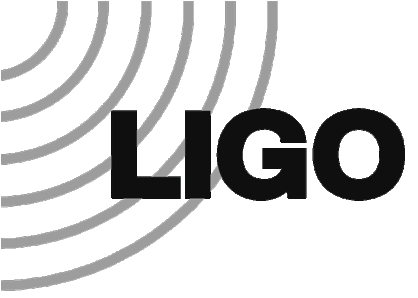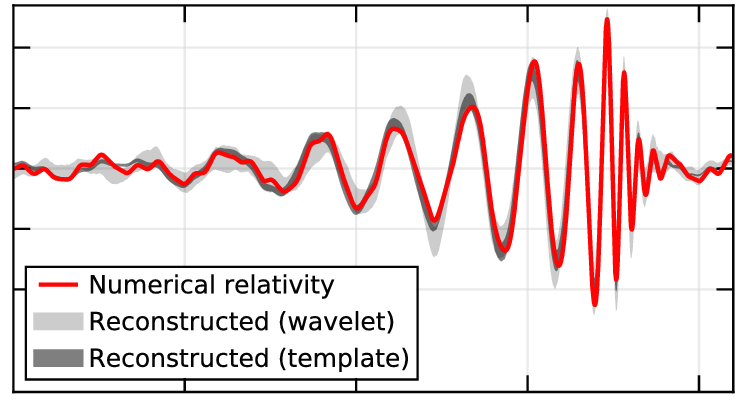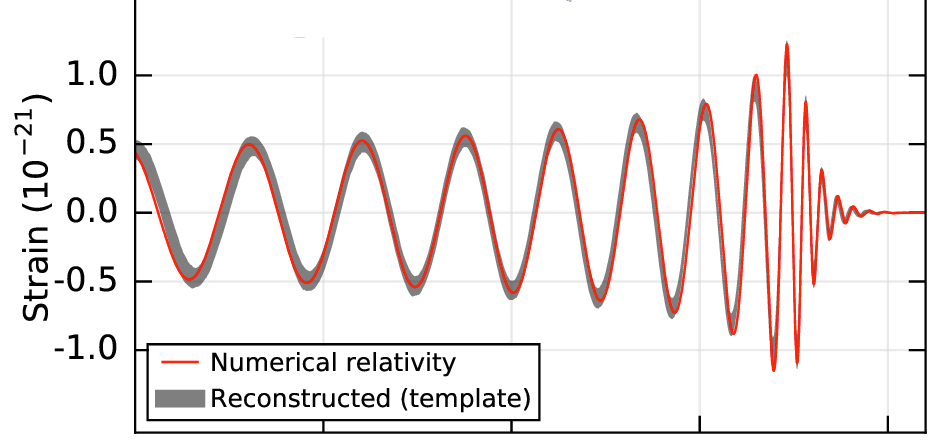
LIGO Open Science Center
LIGO
is operated by
California Institute of Technology
and
Massachusetts Institute of Technology
|

LIGO Open Science Center
LIGO
is operated by
California Institute of Technology
and
Massachusetts Institute of Technology
|
Data release for event GW150914This page has been prepared by the LIGO Scientific Collaboration (LSC) and the Virgo Collaboration to inform the broader community about a confirmed astrophysical event observed by the gravitational-wave detectors, and to make the data around that time available for others to analyze. There is also a technical details page about the data linked below, and feel free to contact us. This dataset has the Digital Object Identifier (doi) http://dx.doi.org/10.7935/K5MW2F23
Summary of ObservationThe event occurred at GPS time 1126259462 == September 14 2015, 09:50:45 UTC. The false alarm rate is estimated to be less than 1 event per 203,000 years, equivalent to a significance of 5.1 sigma. The event was detected in data from the LIGO Hanford and LIGO Livingston observatories.
|
| Quantity | Value | Upper/Lower error estimate | Unit |
|---|---|---|---|
| Primary black hole mass | 36 | +5 -4 | M sun |
| Secondary black hole mass | 29 | +4 -4 | M sun |
| Final black hole mass | 62 | +4 -4 | M sun |
| Final black hole spin | 0.67 | +0.05 -0.07 | |
| Luminosity distance | 410 | +160 -180 | Mpc |
| Source redshift, z | 0.09 | +0.03 -0.04 | |
| Energy radiated | 3 | +0.5 -0.5 | M sun |
TABLE I. Estimated source parameters for GW150914. We report the median value as well as the range of the 90% credible interval. Masses are measured in the source frame; to convert masses to detector frame, multiply by (1 + z). The source redshift assumes standard cosmology.
 |
 |
 |
 |
 |
 |
 |
 |
FIG. 1. The gravitational-wave event GW150914 observed by the LIGO Hanford (H1, left column panels) and Livingston (L1, right column panels) detectors. Times are shown relative to September 14, 2015 at 09:50:45 UTC. For visualization, all time series are filtered with a 35–350 Hz band-pass filter to suppress large fluctuations outside the detectors’ most sensitive frequency band, and band-reject filters to remove the strong instrumental spectral lines seen in the Fig. 3 spectra.
 Reconstructed DATA |
 velocity DATA |
FIG. 2. Left: Estimated gravitational-wave strain amplitude from GW150914 projected onto H1. This shows the full bandwidth of the waveforms, without the filtering used for Fig. 1. Right: The Keplerian effective black hole separation in units of Schwarzschild radii and the effective relative velocity.
 |
Hanford DATA Livingston DATA |
FIG.3. The average measured strain-equivalent noise, or sensitivity, of the Advanced LIGO detectors during the time analyzed to determine the significance of GW150914 (Sept 12 - Oct 20, 2015). Hanford (H1) is shown in red, Livingston (L1) in blue. The solid traces represent the median sensitivity and the shaded regions indicate the 5th and 95th percentile over the analysis period. The narrowband features in the spectra are due to known mechanical resonances, mains power harmonics, and injected signals used for calibration.
 Search Background C3 DATA Search Result C2 C3 DATA Search Background C2 C3 DATA |
 |
FIG. 4. Search results from the generic transient search (left) and the binary coalescence search (right). These histograms show the number of candidate events (orange markers) and the mean number of background events in the search class where GW150914 was found (black lines) as a function of the search detection statistic and with a bin width of 0.2. The scales on the top give the significance of an event in Gaussian standard deviations based on the corresponding noise background . The significance of GW150914 is greater than 5.1 σ and 4.6 σ for the binary coalescence and the generic transient searches, respectively. (Left): Along with the primary search (C3) we also show the results (yellow markers) and background (green curve) for an alternative search that treats events independently of their frequency evolution (C2+C3). The classes C2 and C3 are defined in the text. (Right): The tail in the black-line background of the binary coalescence search is due to random coincidences of GW150914 in one detector with noise in the other detector. (This type of event is practically absent in the generic transient search background because they do not pass the time-frequency consistency requirements used in that search.) The blue curve is the background excluding those coincidences, which is used to assess the significance of the second strongest event candidate.
The data from the observatories from which the science is derived:
| Duration | Hanford | Livingston |
|---|---|---|
| 32 seconds approx 1 Mbyte | DATA hdf5 DATA gwf DATA txt.gz |
DATA hdf5 DATA gwf DATA txt.gz |
| 4096 seconds approx 134 Mbyte | DATA hdf5 DATA gwf DATA txt.gz |
DATA hdf5 DATA gwf DATA txt.gz |
| Duration | Hanford | Livingston |
|---|---|---|
| 32 seconds approx 4 Mbyte | DATA hdf5 DATA gwf DATA txt.gz |
DATA hdf5 DATA gwf DATA txt.gz |
| 4096 seconds approx 536 Mbyte | DATA hdf5 DATA gwf DATA txt.gz |
DATA hdf5 DATA gwf DATA txt.gz |
The Laser Interferometer Gravitational-Wave Observatory (LIGO) consists of two widely separated installations within the United States — one in Hanford, Washington and the other in Livingston, Louisiana — operated in unison as a single observatory. LIGO is operated by the LIGO Laboratory, a consortium of the California Institute of Technology (Caltech) and the Massachusetts Institute of Technology (MIT). Funded by the National Science Foundation, LIGO is an international resource for both physics and astrophysics.
The GEO600 project aims at the direct detection of gravitational waves by means of a laser interferometer of 600 m armlength located near Hannover, Germany. Besides collecting data for gravitational wave searches, the GEO600 detector has been used to develop and test advanced instrumentation for gravitational wave detection.
The LIGO Scientific Collaboration (LSC) is a group of scientists seeking to make the first direct detection of gravitational waves, use them to explore the fundamental physics of gravity, and develop the emerging field of gravitational wave science as a tool of astronomical discovery. The LSC works toward this goal through research on, and development of techniques for, gravitational wave detection, and the development, commissioning and exploitation of gravitational wave detectors. The LSC carries out the science of the LIGO and GEO600 Observatories. Participation in the LSC is open to all interested scientists and engineers from educational and research institutions.
 |
Hanford DATA Livingston DATA |
 | DATA |
FIG 3. The rate at which sensitive time-volume accumulates with redshift.
 |
R1 DATA, gstlal |
pycbc R2 DATA, gstlal | pycbc R DATA, gstlal | pycbc |
FIG 4. The posterior density on the rate of GW150914-like BBH inspirals, R1 (green), G197392-like BBH inspirals, R2 (red), and the inferred total rate, R = R1 + R2 (blue).
 |
Flat DATA, gstlal |
pycbc Powerlaw DATA, gstlal | pycbc |
FIG 5. Sensitivity of the inferred BBH coalescence rate to the assumed astrophysical distribution BBH masses. The curves represent the posterior assuming that BBH masses are flat in log (m1)- log (m2) (blue; “Flat”), are exactly GW150914-like or G197392- like as described in Section 2 (green; “Reference”), or are distributed as in Eq. (20) (red; “Power Law”).
 |
DATA |
 |
Hanford DATA Livingston DATA |
FIG.1 The average measured strain-equivalent noise, or sensitivity, of the Advanced LIGO detectors during the time analyzed to determine the significance of GW150914 (Sept 12 - Oct 20, 2015). Hanford (H1) is shown in red, Livingston (L1) in blue. The solid traces represent the median sensitivity and the shaded regions indicate the 5th and 95th percentile over the analysis period. The narrowband features in the spectra are due to known mechanical resonances, mains power harmonics, and injected signals used for calibration
Anthology of papers describing the technology of LIGO can be found at:
Quest for Detection: Articles from Review of Scientific Instruments
.
Sky location probability maps
Four pipelines produced sky localization information, known as CWB, LIB, BAYESTAR, and LALInference. Their sky coverage comparison is shown below, in equatorial coordinates:
The skymaps can be visualized in astronomical context with the Skymap Viewer, as in the right-hand image: CWB, LIB, BAYESTAR, LALInference.
The skymaps are represented as HEALPIX-FITS files in equatorial frame, available gzipped:
A python library for reading such files is healpy. A very simple healpy code to work with LIGO-Virgo skymaps is here. A large number of simulated skymaps is available here.
There is a technical details page about the data linked above, and
feel free to contact us.